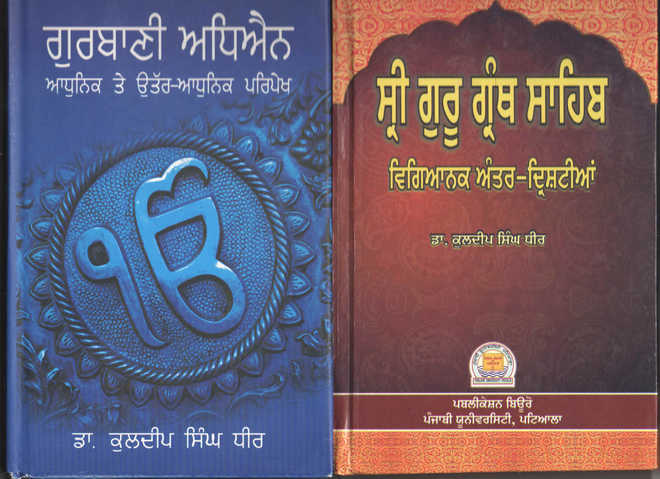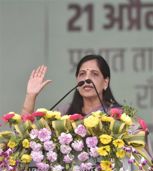
Jaspal Singh
Punjabi writer Kuldip Singh Dheer has written more than five dozen books, big or small, and three dozen of these are on scientific topics. He has also done a lot of research into Sikh religious matters, the latest being two important studies — Sri Guru Granth Sahib: Vigyanik Anter-Drishtiyan (Scientific Insights in Guru Granth Sahib) Punjabi University, Patiala and Gurbani Adhyan: Adhunikte Uttar Adhunik Paripekh (Study of Gurbani: A Modern and Post-Modern Perspective) Shilalekh, Delhi.
Both these treatises are a stupendous intellectual effort to understand Sikh scriptures through modern scientific and philosophical ruminations. That is why these writings are dotted with the names of scientists like Albert Einstein, Stephen Hawking, Martin Reas, Niels Bohr, Alan Guth and so on, along with the names of the Sikh Gurus, particularly that of Guru Nanak, who though was not a scientist, yet had a cosmological vision as vast as that of the modern scientists. The author maintains that Guru Nanak’s belief in the infinite transcendental cosmos may not be based on any empirical scientific investigation, yet it broadly conforms to results of modern scientific enquiry.
Similarly Guru Nanak’s idea of Akalpurkh, who as Kartapurkh created the universe and regulates it in accordance with certain laws of nature without interfering in human affairs, is unique. Humanism and egalitarianism are central to the Sikh creed. Apart from this, Sikhism believes in personal and social equilibrium leading to equanimity and communitarian harmony. Guru Nanak believed in honest labour and he set an example by becoming an ordinary farmer at Kartarpur after having undertaken four long journeys across many countries of the world. Dheer quotes profusely from the holy verses of Guru Nanak to prove his point.
In almost all other religious texts, the cosmological vision of space and time is subject to historical specificity of the creed. But despite these generalisations, one cannot claim that Sikhism is an absolutely scientific religion, which Dheer is trying to establish by selectively choosing the quotes in an eclectic manner. It is better to keep science and scriptures apart. At many places, scriptural narrative may go against the established scientific principles and discoveries. If the medieval theologies had solved all the scientific problems of the material world, there would have been no Einsteins and Niels Bohrs.
In addition to cosmology of Sikhism, Dheer compares Sikh doctrine with Sankhya school of philosophy, the karma theory and mysticism in general. The insights shown by him are revealing. But the post-modern reading of the Gurbani through the prisms of Jacques Derrida, Jean Baudrilard, Michel Foucault, Jean-Francois Lyotard and Gilles Deleuze, sometimes leads to unintended results.
No doubt an attempt has been made to show that the Guru Granth Sahib brings the discourse of the ‘other’ to the centrestage of ideation, which most of the other religions ignore. The dialectical unity of the thakur (master) and sevak (servant) the daata (giver) and bhugta (consumer) and that of the Guru (teacher) and the chela (taught) that is of the ‘subject’ and the ‘object’ has been emphasised upon and achieved in the Gurbani much before the modern philosophers tried to restore it after surmounting Cartesian psycho-physical dualism. But the post-modern deconstruction of the text does not stop at that. Its micro-analytical method of reading the text between the lines can decompose and destabilise the established semantic assumptions of Sikhism. So the discourse of the Gurbani cannot and should not be maintained as a post-modern discourse for obvious reasons.
Guru Granth Sahib is a revolutionary text in the sense that it enunciated the message of liberty, equality and fraternity much before the modern thinkers conceived it, though in the modern democraticnation-state, the semantic load of these ideas has changed at the pragmatic level. Therefore, the heady brew of religion, science, modernism and post-modernism may disturb the accepted order of things. Religion in such a situation would be mauled beyond recognition.
Despite all these limitations, Dheer’s analysis and insights lead to an alternative reading of the Gurbani which at least is different from the beaten track followed since centuries. There is so much in the Gurbani to be explored and reinterpreted with the help of modern intellectual tools. Reading of holy verses without digging out new layers of meanings that they carry in the present context may prove to be a futile exercise that the great Gurus never wanted their votaries to follow. So, Dheer being a suave academician and a former university dean has adhered to the norms of traditional academic culture to that extent.



























